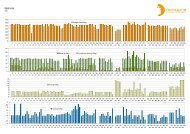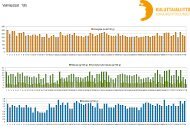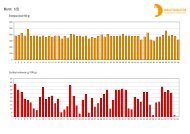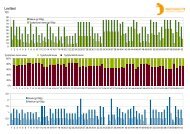Marketing unhealthy food to children in Asia Pacific - Consumers ...
Marketing unhealthy food to children in Asia Pacific - Consumers ...
Marketing unhealthy food to children in Asia Pacific - Consumers ...
- No tags were found...
Create successful ePaper yourself
Turn your PDF publications into a flip-book with our unique Google optimized e-Paper software.
In <strong>Asia</strong> <strong>Pacific</strong>, childhood overweight and obesity ratesare ris<strong>in</strong>g faster than anywhere else <strong>in</strong> the world. In SouthEast <strong>Asia</strong>, between 2005 and 2010 overweight andobesity levels for the school-aged population is expected<strong>to</strong> rise by 27.5%. In Western <strong>Pacific</strong> the figure is 23.5% 6 .The WHO has estimated that noncommunicablediseases cause around 60%of deaths a year and the majorityof these deaths occur <strong>in</strong> low andmiddle-<strong>in</strong>come countriesThe role of <strong>food</strong> market<strong>in</strong>gMany fac<strong>to</strong>rs contribute <strong>to</strong> the risk of develop<strong>in</strong>g obesity.One that has been identified is the way that <strong>unhealthy</strong><strong>food</strong> or products that are energy dense and nutrient poorare marketed <strong>to</strong> <strong>children</strong>.In 2006, the WHO’s Technical Meet<strong>in</strong>g on <strong>Market<strong>in</strong>g</strong> ofFood and Non-Alcoholic Beverages <strong>to</strong> Children concludedthat exposure <strong>to</strong> the promotion of energy dense, nutrientpoor <strong>food</strong>s and beverages can adversely affect <strong>children</strong>’seat<strong>in</strong>g habits. They advised that robust science andresearch shows that there is extensive <strong>food</strong> and beveragepromotion <strong>to</strong> <strong>children</strong>; <strong>children</strong> are aware of, appreciativeof, and engage with this promotion. They also found thatthe market<strong>in</strong>g is overwhelm<strong>in</strong>gly for energy-dense,micronutrient-poor <strong>food</strong>s, which underm<strong>in</strong>esrecommendations for a healthy diet.Professor Gerard Hast<strong>in</strong>gs <strong>in</strong> his review of the evidence 7for the WHO concluded that <strong>children</strong> <strong>in</strong> develop<strong>in</strong>gcountries may be more vulnerable <strong>to</strong> advertis<strong>in</strong>g of<strong>unhealthy</strong> <strong>food</strong> because:• They are less familiar with advertis<strong>in</strong>g <strong>in</strong> general.• They are a key entry po<strong>in</strong>t for companies as they aremore responsive than their parents.• They may associate Western mult<strong>in</strong>ational companybrands with a desirable modern lifestyle.The Global Strategy on Diet, Physical Activity and Health,which was agreed at the World Health Assembly (WHA)<strong>in</strong> May 2004 8 , recognises that <strong>in</strong> order <strong>to</strong> create anenvironment that enables a healthier diet and morephysical activity, a number of fac<strong>to</strong>rs must be tackledsimultaneously. One of the issues identified is <strong>food</strong>market<strong>in</strong>g, which <strong>in</strong>cludes advertis<strong>in</strong>g, sponsorship andpromotion. S<strong>in</strong>ce the adoption of the Global Strategy, theevidence for action on <strong>food</strong> market<strong>in</strong>g <strong>to</strong> <strong>children</strong> hasstrengthened further.Mult<strong>in</strong>ational companies have beenable <strong>to</strong> exploit the lack of controls andregulations on market<strong>in</strong>g andadvertis<strong>in</strong>g <strong>in</strong> develop<strong>in</strong>g countriesOverall the WHO concluded that advertis<strong>in</strong>g has anadverse effect on <strong>children</strong>’s understand<strong>in</strong>g of <strong>food</strong>knowledge, attitude, purchase behaviour andconsumption.Mult<strong>in</strong>ational companies have been able <strong>to</strong> exploit thelack of controls and regulations on market<strong>in</strong>g andadvertis<strong>in</strong>g <strong>in</strong> develop<strong>in</strong>g countries and have been us<strong>in</strong>ga range of techniques <strong>to</strong> promote <strong>food</strong>s, which are high<strong>in</strong> fat, sugar and salt <strong>to</strong> <strong>children</strong>. The CI/IOTF Codedef<strong>in</strong>es ‘<strong>children</strong>’ as younger than 16 years old.Fast <strong>food</strong> <strong>in</strong> FijiThe <strong>food</strong> trap11
















